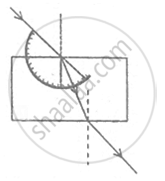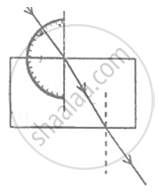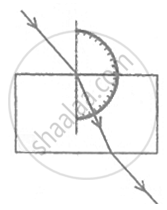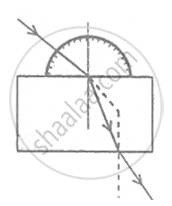Advertisements
Advertisements
Question
A small object is placed 150 mm away from a diverging lens of focal length 100 mm.
(i) Copy the figure below and draw rays to show how an image is formed by the lens.
Figure
(ii) Calculate the distance of the image from the lens by using the lens formula.
Solution
The image formed by the lens is virtual, erect and diminished in size.

(a)(ii) Object distance (u) = -150 mm = -15 cm (sign convention)
Focal length (f) = -100 mm = -10 cm (sign convention)
Image distance (v) = ?
Applying the lens formula, we have:
`1/v-1/u=1/f`
`1/v-1/-15=1/-10`
`1/v+1/15=-1/10`
`1/v=1/10-1/15`
`1/v=(-3-2)/30`
`1/v=(-5)/30`
`v=-6 cm `
APPEARS IN
RELATED QUESTIONS
What is the relation between the focal length and radius of curvature of a spherical mirror (concave mirror of convex mirror)? Calculate the focal length of a spherical mirror whose radius of curvature is 25 cm.
A concave lens produces an image 20 cm from the lens of an object placed 30 cm from the lens. The focal length of the lens is:
(a) 50 cm
(b) 40 cm
(c) 60 cm
(d) 30 cm
State the number of images of an object placed between two mirrors, formed in each case when mirrors are inclined to each other at (a) 90°, and (b) 60°.
A point light source is kept in front of a convex mirror at a distance of 40 cm. The focal length of the mirror is 40 cm. Find the position of image.
Define the following term:
concave mirror
Define linear magnification produced by a mirror?
Find the height of the image of a body of height 1.5m in a mirror with a magnification of 1.5.
A student traces the path of a ray of light passing through a rectangular slab.
 |
 |
 |
 |
For measuring the angle of incidence, he must position the protractor in the manner shown in the figure:
Visit a nearby hospital. You can also visit the clinic of an ENT specialist, or a dentist. Request the doctor to show you the mirrors used for examining ear, nose, throat and teeth. Can you recognise the kind of mirror used in these instruments?
